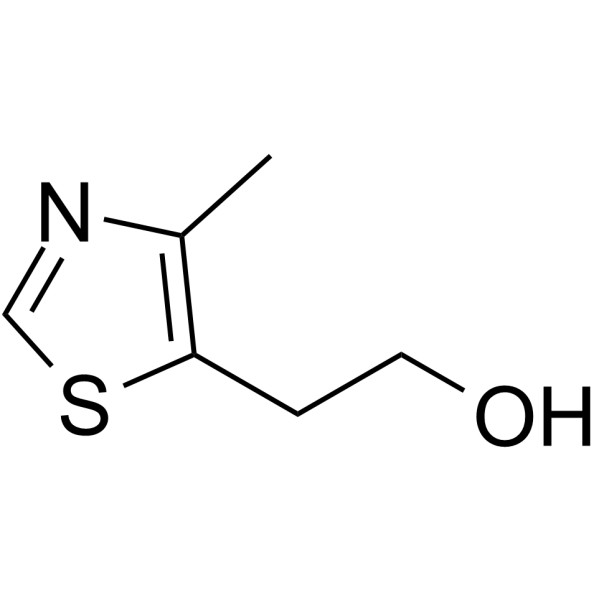Sulfurol

Sulfurol structure
|
Common Name | Sulfurol | ||
|---|---|---|---|---|
| CAS Number | 137-00-8 | Molecular Weight | 143.20 | |
| Density | 1.2±0.1 g/cm3 | Boiling Point | 272.4±0.0 °C at 760 mmHg | |
| Molecular Formula | C6H9NOS | Melting Point | N/A | |
| MSDS | Chinese USA | Flash Point | 109.7±23.2 °C | |
| Symbol |

GHS07 |
Signal Word | Warning | |
|
Metabolomic profiling of Burkholderia pseudomallei using UHPLC-ESI-Q-TOF-MS reveals specific biomarkers including 4-methyl-5-thiazoleethanol and unique thiamine degradation pathway.
Cell Biosci. 5 , 26, (2015) Burkholderia pseudomallei is an emerging pathogen that causes melioidosis, a serious and potentially fatal disease which requires prolonged antibiotics to prevent relapse. However, diagnosis of melioidosis can be difficult, especially in culture-negative case... |
|
|
Synthesis and odor evaluation of five new sulfur-containing ester flavor compounds from 4-ethyloctanoic acid.
Molecules 15(8) , 5104-11, (2010) Five sulfur-containing flavor compounds were synthesized for the first time by the reaction of 4-ethyloctanoyl chloride with sulfur-containing alcohols or mercaptans. The synthesized compounds are 3-(methylthio)propyl 4-ethyloctanoate, 2-methyl-3-tetrahydro-f... |
|
|
Characterization of thiI, a new gene involved in thiazole biosynthesis in Salmonella typhimurium.
J. Bacteriol. 179(13) , 4399-402, (1997) Thiamine pyrophosphate (TPP) is a required cofactor in Salmonella typhimurium that is generated de novo by the condensation of 4-amino-5-hydroxymethyl pyrimidine (HMP) pyrophosphate and 4-methyl-5-(beta-hydroxyethyl)-thiazole (THZ) monophosphate. The THZ and ... |
|
|
Transport of thiamine and 4-methyl-5-hydroxyethylthiazole by Salmonella typhimurium.
Biochim. Biophys. Acta 735(3) , 331-6, (1983) The transport of thiamine and 4-methyl-5-hydroxyethylthiazole (MHET), its thiazole moiety, was studied using whole cells of Salmonella typhimurium. It was found that the bacteria possessed an active transport system for thiamine that had Km 0.21 microM and Vm... |
|
|
A positive regulatory gene, THI3, is required for thiamine metabolism in Saccharomyces cerevisiae.
J. Bacteriol. 174(14) , 4701-6, (1992) We have isolated a thiamine auxotrophic mutant carrying a recessive mutation which lacks the positive regulatory gene, THI3, which differs in the regulation of thiamine transport from the THI2 (PHO6) gene described previously (Y. Kawasaki, K. Nosaka, Y. Kanek... |
|
|
The apbE gene encodes a lipoprotein involved in thiamine synthesis in Salmonella typhimurium.
J. Bacteriol. 180(4) , 885-91, (1998) Thiamine pyrophosphate is an essential cofactor that is synthesized de novo in Salmonella typhimurium. The biochemical steps and gene products involved in the conversion of aminoimidazole ribotide (AIR), a purine intermediate, to the 4-amino-5-hydroxymethyl-2... |
|
|
Amiloride toxicity in the fission yeast Schizosaccharomyces pombe is released by thiamine and mutations in the thiamine-repressible gene car1.
Gene 171(1) , 119-22, (1996) Amiloride (Am) inhibits growth in the fission yeast Schizosaccharomyces pombe. We show that the toxic effect of this drug is relieved by low concentrations of thiamine (Th) and that the pyrimidine moiety of the Th molecule is responsible for growth inhibition... |
|
|
Biosynthesis of thiamin thiazole: determination of the regiochemistry of the S/O acyl shift by using 1,4-dideoxy-D-xylulose-5-phosphate.
Angew. Chem. Int. Ed. Engl. 45(21) , 3507-10, (2006)
|
|
|
Thiamine requirement of Eikenella corrodens.
Microbios 63(255) , 117-25, (1990) The thiamine requirement for growth of Eikenella corrodens was investigated. Autoclaved thiamine at a concentration of 1.0 microgram/ml supported maximal growth whereas for the same growth, filter-sterilized thiamine was required at 50-100 micrograms/ml. Stud... |
|
|
[Effect of thiamine and its derivatives on acetylcholinesterase activity of the blood and brain of albino mice].
Ukr. Biokhim. Zh. 59(3) , 76-9, (1987) Thiamine, thiaminepyrophosphate and 4-methyl-5-beta-oxyethylthiazole are studied for their effect on the acetylcholinesterase activity in the brain, blood plasma and cells. The activity of acetylcholinesterase in blood cells is shown to be inhibited most of a... |